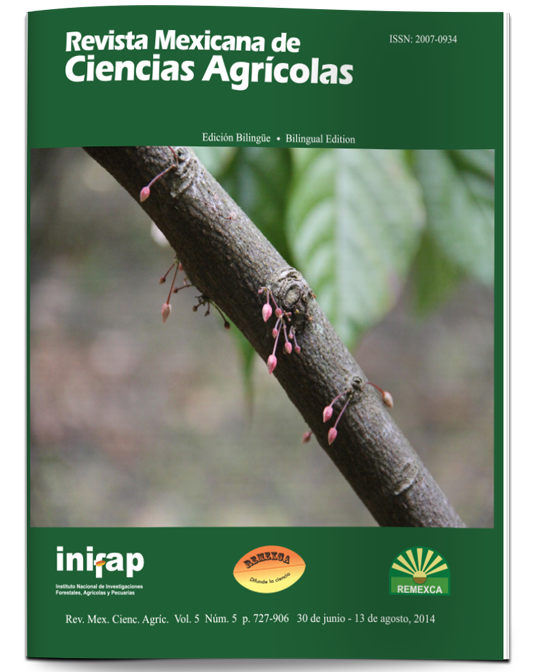Analysis of 17 maize hybrids grown in 17 environments from the Highlands of Central Mexico
DOI:
https://doi.org/10.29312/remexca.v5i5.910Keywords:
Zea mays L., assessment in farmers' f ields, elite hybrids, multivariate methods, t testAbstract
The Highlands of Central Mexico is a very important region for the production of maize (Zea mays L.) and specifically for breeding and technology for the generation of agricultural area. In this study were evaluated in demonstration and validation 17 maize hybrids in 17 environments in this region plots to identify outstanding genetic material considering its performance mainly grain, plant and ear heights and the growing cycle of the cultivars. The main results showed that the 17 hybrid material could be classified as intermediate cycle based on male blooms (87 to 97 days) and female (89.4 to 99 days). The variable most affected by the heterogeneity among the 17 environments from central Mexico was the grain yield (RG), which ranged from 2.20 (El Batán date 2) to 8.64 t (Tlaxcoapan); the difference between minor and major towns of RG was 6.44 t. Tlaxcoapan, Santa Lucía, Amealco (date 1), Boximo and Epitacio Huerta was the best locations (8.19, 8.10, 7.35 and 7.95 t) for the evaluation of the tests. H-55, regarded as the control was 6.30 t ha-1 and was only statistically surpassed by CMT 099 004 (6.90 t ha-1). Cultivars H-55, CML457 / CML459//IML-6, 099003 CMT, CMT 099 027, H-57, 0290502 CMT, CMT and Insurgentes 099 002 (from 6.1 to 6.3 t ha-1) had statistically identical RG. The previous eight hybrids represent the most outstanding to start new breeding programs or technology generation material and are also recommended for the production of certified seed or commercial planting in the study area.
Downloads
Downloads
Published
How to Cite
Issue
Section
License
The authors who publish in Revista Mexicana de Ciencias Agrícolas accept the following conditions:
In accordance with copyright laws, Revista Mexicana de Ciencias Agrícolas recognizes and respects the authors’ moral right and ownership of property rights which will be transferred to the journal for dissemination in open access. Invariably, all the authors have to sign a letter of transfer of property rights and of originality of the article to Instituto Nacional de Investigaciones Forestales, Agrícolas y Pecuarias (INIFAP) [National Institute of Forestry, Agricultural and Livestock Research]. The author(s) must pay a fee for the reception of articles before proceeding to editorial review.
All the texts published by Revista Mexicana de Ciencias Agrícolas —with no exception— are distributed under a Creative Commons License Attribution-NonCommercial 4.0 International (CC BY-NC 4.0), which allows third parties to use the publication as long as the work’s authorship and its first publication in this journal are mentioned.
The author(s) can enter into independent and additional contractual agreements for the nonexclusive distribution of the version of the article published in Revista Mexicana de Ciencias Agrícolas (for example include it into an institutional repository or publish it in a book) as long as it is clearly and explicitly indicated that the work was published for the first time in Revista Mexicana de Ciencias Agrícolas.
For all the above, the authors shall send the Letter-transfer of Property Rights for the first publication duly filled in and signed by the author(s). This form must be sent as a PDF file to: revista_atm@yahoo.com.mx; cienciasagricola@inifap.gob.mx; remexca2017@gmail.
This work is licensed under a Creative Commons Attribution-Noncommercial 4.0 International license.



